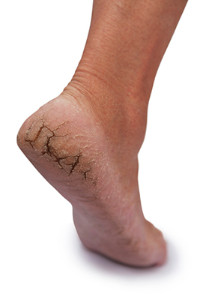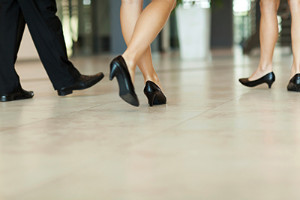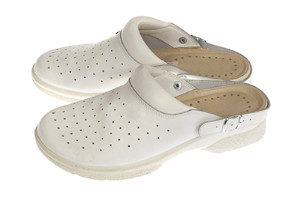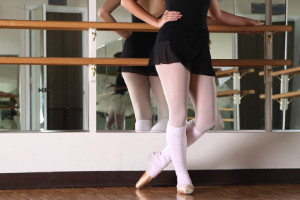
Blog (871)
Getting to the Cause of Cracked Heels
 While typically not as serious as some other conditions, cracked heels can be very uncomfortable for those who have them. Knowing the causes of cracked heels and what to look for allows you to prevent and treat them. Dry skin is one of the most common causes for cracked heels and generally occurs right before cracks develop. Moisturizing your feet will help prevent and alleviate this dryness. Too much pressure on your feet is another cause of cracked heels, so giving your feet a rest and wearing comfortable shoes will help prevent cracks. Athlete’s foot, psoriasis, and eczema can all lead to redness, flaky skin, peeling skin, and cracked heels. Athlete’s foot can typically be treated with antifungal spray. While psoriasis and eczema have no known cures, topical corticosteroids can help mitigate the effects that lead to cracked heels. Finally, for beach goers, sunburn can lead to cracked heels. Aloe Vera creams may also help soothe sunburned skin. If cracked heels lead to pain or do not go away, see a podiatrist for treatment and advice.
While typically not as serious as some other conditions, cracked heels can be very uncomfortable for those who have them. Knowing the causes of cracked heels and what to look for allows you to prevent and treat them. Dry skin is one of the most common causes for cracked heels and generally occurs right before cracks develop. Moisturizing your feet will help prevent and alleviate this dryness. Too much pressure on your feet is another cause of cracked heels, so giving your feet a rest and wearing comfortable shoes will help prevent cracks. Athlete’s foot, psoriasis, and eczema can all lead to redness, flaky skin, peeling skin, and cracked heels. Athlete’s foot can typically be treated with antifungal spray. While psoriasis and eczema have no known cures, topical corticosteroids can help mitigate the effects that lead to cracked heels. Finally, for beach goers, sunburn can lead to cracked heels. Aloe Vera creams may also help soothe sunburned skin. If cracked heels lead to pain or do not go away, see a podiatrist for treatment and advice.
Cracked heels are unsightly and can cause further damage to your shoes and feet. If you have any concerns, contact one of our podiatrists from Dr. Kane & Associates, P.C. Our doctors can provide the care you need to keep you pain-free and on your feet.
Cracked Heels
Cracked heels appear unappealing and can make it harder for you walk around in sandals. Aside from looking unpleasant, cracked heels can also tear stockings, socks, and wear out your shoes. There are several methods to help restore a cracked heel and prevent further damage.
How Do You Get Them?
Dry skin is the number one culprit in creating cracked heels. Many athletes, walkers, joggers, and even swimmers suffer from cracked heels. Age and skin oil production play a role to getting cracked heels as well.
Promote Healing
Over the counter medicines can help, especially for those that need instant relief or who suffer from chronic dry feet.
Wear Socks – Wearing socks with medicated creams helps lock in moisture.
Moisturizers – Applying both day and night will help alleviate dryness which causes cracking.
Pumice Stones – These exfoliate and remove dead skin, which allows for smoother moisturizer application and better absorption into the skin.
Change in Diet
Eating healthy with a well-balanced diet will give the skin a fresh and radiant look. Your body responds to the kinds of food you ingest. Omega-3 fatty acids and zinc supplements can also revitalize skin tissue.
Most importantly, seek professional help if unsure how to proceed in treating cracked heels. A podiatrist will help you with any questions or information needed.
If you have any questions, please feel free to contact our office located in Westland, MI.. We offer the newest diagnostic and treatment technologies for all your foot care needs.
Read more about Solutions for Cracked HeelsGetting to the Cause of Cracked Heels
 While typically not as serious as some other conditions, cracked heels can be very uncomfortable for those who have them. Knowing the causes of cracked heels and what to look for allows you to prevent and treat them. Dry skin is one of the most common causes for cracked heels and generally occurs right before cracks develop. Moisturizing your feet will help prevent and alleviate this dryness. Too much pressure on your feet is another cause of cracked heels, so giving your feet a rest and wearing comfortable shoes will help prevent cracks. Athlete’s foot, psoriasis, and eczema can all lead to redness, flaky skin, peeling skin, and cracked heels. Athlete’s foot can typically be treated with antifungal spray. While psoriasis and eczema have no known cures, topical corticosteroids can help mitigate the effects that lead to cracked heels. Finally, for beach goers, sunburn can lead to cracked heels. Aloe Vera creams may also help soothe sunburned skin. If cracked heels lead to pain or do not go away, see a podiatrist for treatment and advice.
While typically not as serious as some other conditions, cracked heels can be very uncomfortable for those who have them. Knowing the causes of cracked heels and what to look for allows you to prevent and treat them. Dry skin is one of the most common causes for cracked heels and generally occurs right before cracks develop. Moisturizing your feet will help prevent and alleviate this dryness. Too much pressure on your feet is another cause of cracked heels, so giving your feet a rest and wearing comfortable shoes will help prevent cracks. Athlete’s foot, psoriasis, and eczema can all lead to redness, flaky skin, peeling skin, and cracked heels. Athlete’s foot can typically be treated with antifungal spray. While psoriasis and eczema have no known cures, topical corticosteroids can help mitigate the effects that lead to cracked heels. Finally, for beach goers, sunburn can lead to cracked heels. Aloe Vera creams may also help soothe sunburned skin. If cracked heels lead to pain or do not go away, see a podiatrist for treatment and advice.
Cracked heels are unsightly and can cause further damage to your shoes and feet. If you have any concerns, contact one of our podiatrists from Westland Foot & Ankle Specialists, P.C.. Our doctors can provide the care you need to keep you pain-free and on your feet.
Cracked Heels
Cracked heels appear unappealing and can make it harder for you walk around in sandals. Aside from looking unpleasant, cracked heels can also tear stockings, socks, and wear out your shoes. There are several methods to help restore a cracked heel and prevent further damage.
How Do You Get Them?
Dry skin is the number one culprit in creating cracked heels. Many athletes, walkers, joggers, and even swimmers suffer from cracked heels. Age and skin oil production play a role to getting cracked heels as well.
Promote Healing
Over the counter medicines can help, especially for those that need instant relief or who suffer from chronic dry feet.
Wear Socks – Wearing socks with medicated creams helps lock in moisture.
Moisturizers – Applying both day and night will help alleviate dryness which causes cracking.
Pumice Stones – These exfoliate and remove dead skin, which allows for smoother moisturizer application and better absorption into the skin.
Change in Diet
Eating healthy with a well-balanced diet will give the skin a fresh and radiant look. Your body responds to the kinds of food you ingest. Omega-3 fatty acids and zinc supplements can also revitalize skin tissue.
Most importantly, seek professional help if unsure how to proceed in treating cracked heels. A podiatrist will help you with any questions or information needed.
If you have any questions, please feel free to contact our office located in Westland, MI. . We offer the newest diagnostic and treatment technologies for all your foot care needs.
Podiatrists and Pedicurists
 Podiatrists are doctors who specialize in the foot and ankle and can treat the most severe foot conditions. While conditions like corns, calluses, foot fungus, and cracked heels may seem minor to some, podiatrists offer the best solutions when it comes to fixing them. Pedicurists, on the other hand, are cosmeticians and cannot treat foot ailments. Pedicurists may also not know what a fungal infection like athlete's foot looks like and may therefore be unable to alert you if you have the condition. Despite this, pedicures are a great way to beautify and maintain clean-looking feet. Just ensure that the pedicure salon uses clean instruments, as unclean tools can potentially lead to fungal infections. Be wary of the type of nail polish used by a pedicurist, as certain varieties can be harsh on nails and preserve and hide toenail infections. If the pedicurist cuts skin around the cuticle, this is potentially dangerous and can also lead to infections. Above all, be aware of what is going on in a pedicure salon; remember that pedicurists are not podiatrists and cannot help with foot conditions. If you have an issue with your feet, see a podiatrist for proper care.
Podiatrists are doctors who specialize in the foot and ankle and can treat the most severe foot conditions. While conditions like corns, calluses, foot fungus, and cracked heels may seem minor to some, podiatrists offer the best solutions when it comes to fixing them. Pedicurists, on the other hand, are cosmeticians and cannot treat foot ailments. Pedicurists may also not know what a fungal infection like athlete's foot looks like and may therefore be unable to alert you if you have the condition. Despite this, pedicures are a great way to beautify and maintain clean-looking feet. Just ensure that the pedicure salon uses clean instruments, as unclean tools can potentially lead to fungal infections. Be wary of the type of nail polish used by a pedicurist, as certain varieties can be harsh on nails and preserve and hide toenail infections. If the pedicurist cuts skin around the cuticle, this is potentially dangerous and can also lead to infections. Above all, be aware of what is going on in a pedicure salon; remember that pedicurists are not podiatrists and cannot help with foot conditions. If you have an issue with your feet, see a podiatrist for proper care.
If you are experiencing pain in the feet or ankles, don’t join the stubborn majority refusing treatment. Feel free to contact one of our podiatrists from Dr. Kane & Associates, P.C. Our doctors can provide the care you need to keep you pain-free and on your feet.
What Is a Podiatrist?
Someone would seek the care of a podiatrist if they have suffered a foot injury or have common foot ailments such as heal spurs, bunions, arch problems, deformities, ingrown toenails, corns, foot and ankle problems, etc.
Podiatric Treatment
A podiatrist will treat the problematic areas of the feet, ankle or lower leg by prescribing the following:
- Physical therapy
- Drugs
- Orthotic inserts or soles
- Surgery on lower extremity fractures
A common podiatric procedure a podiatrist will use is a scanner or force plate which will allow the podiatrist to know the designs of orthotics. Patients are then told to follow a series of tasks to complete the treatment. The computer will scan the foot a see which areas show weight distribution and pressure points. The podiatrist will read the analysis and then determine which treatment plans are available.
If you have any questions please feel free to contact our office located in Westland, MI.. We offer the newest diagnostic and treatment technologies for all your foot and ankle needs.
Read more about What is a Podiatrist?Podiatrists and Pedicurists
 Podiatrists are doctors who specialize in the foot and ankle and can treat the most severe foot conditions. While conditions like corns, calluses, foot fungus, and cracked heels may seem minor to some, podiatrists offer the best solutions when it comes to fixing them. Pedicurists, on the other hand, are cosmeticians and cannot treat foot ailments. Pedicurists may also not know what a fungal infection like athlete's foot looks like and may therefore be unable to alert you if you have the condition. Despite this, pedicures are a great way to beautify and maintain clean-looking feet. Just ensure that the pedicure salon uses clean instruments, as unclean tools can potentially lead to fungal infections. Be wary of the type of nail polish used by a pedicurist, as certain varieties can be harsh on nails and preserve and hide toenail infections. If the pedicurist cuts skin around the cuticle, this is potentially dangerous and can also lead to infections. Above all, be aware of what is going on in a pedicure salon; remember that pedicurists are not podiatrists and cannot help with foot conditions. If you have an issue with your feet, see a podiatrist for proper care.
Podiatrists are doctors who specialize in the foot and ankle and can treat the most severe foot conditions. While conditions like corns, calluses, foot fungus, and cracked heels may seem minor to some, podiatrists offer the best solutions when it comes to fixing them. Pedicurists, on the other hand, are cosmeticians and cannot treat foot ailments. Pedicurists may also not know what a fungal infection like athlete's foot looks like and may therefore be unable to alert you if you have the condition. Despite this, pedicures are a great way to beautify and maintain clean-looking feet. Just ensure that the pedicure salon uses clean instruments, as unclean tools can potentially lead to fungal infections. Be wary of the type of nail polish used by a pedicurist, as certain varieties can be harsh on nails and preserve and hide toenail infections. If the pedicurist cuts skin around the cuticle, this is potentially dangerous and can also lead to infections. Above all, be aware of what is going on in a pedicure salon; remember that pedicurists are not podiatrists and cannot help with foot conditions. If you have an issue with your feet, see a podiatrist for proper care.
If you are experiencing pain in the feet or ankles, don’t join the stubborn majority refusing treatment. Feel free to contact one of our podiatrists from Westland Foot & Ankle Specialists, P.C.. Our doctors can provide the care you need to keep you pain-free and on your feet.
What Is a Podiatrist?
Someone would seek the care of a podiatrist if they have suffered a foot injury or have common foot ailments such as heal spurs, bunions, arch problems, deformities, ingrown toenails, corns, foot and ankle problems, etc.
Podiatric Treatment
A podiatrist will treat the problematic areas of the feet, ankle or lower leg by prescribing the following:
- Physical therapy
- Drugs
- Orthotic inserts or soles
- Surgery on lower extremity fractures
A common podiatric procedure a podiatrist will use is a scanner or force plate which will allow the podiatrist to know the designs of orthotics. Patients are then told to follow a series of tasks to complete the treatment. The computer will scan the foot a see which areas show weight distribution and pressure points. The podiatrist will read the analysis and then determine which treatment plans are available.
If you have any questions please feel free to contact our office located in Westland, MI. . We offer the newest diagnostic and treatment technologies for all your foot and ankle needs.
How to Take Care of Your Feet if You Work While Standing
 For those who stand most of the day while working, foot pain is common. However, there are things you can do to alleviate pain. The type of shoes you wear have a big impact on their wearability. Shoes should have enough space so that toes can move freely. Shoes like open-back heels and sandals are not very supportive and can be bad for feet. Women should also avoid high heels. Shoes should also support the arch, and if not, podiatrists offer custom-made orthotics. Athletic shoes generally offer more support and are a good choice. Stretching your feet can help deal with pain, as can soaking them in a tub. Wearing clean, dry socks can prevent athlete’s foot; foot powder can as well, while also keeping them dry. While you may have to stand all day while you work, this doesn’t mean you have to experience discomfort.
For those who stand most of the day while working, foot pain is common. However, there are things you can do to alleviate pain. The type of shoes you wear have a big impact on their wearability. Shoes should have enough space so that toes can move freely. Shoes like open-back heels and sandals are not very supportive and can be bad for feet. Women should also avoid high heels. Shoes should also support the arch, and if not, podiatrists offer custom-made orthotics. Athletic shoes generally offer more support and are a good choice. Stretching your feet can help deal with pain, as can soaking them in a tub. Wearing clean, dry socks can prevent athlete’s foot; foot powder can as well, while also keeping them dry. While you may have to stand all day while you work, this doesn’t mean you have to experience discomfort.
While working on the feet, it is important to take the proper care of them. For more information about working on your feet, contact one of our podiatrists from Dr. Kane & Associates, P.C. Our doctors will treat your foot and ankle needs.
Working on Your Feet
Standing on your feet for long periods of time can cause stress and pain in your feet. Your whole body may experience change in terms of posture, back pain, bunions, callouses and or plantar warts. There are ways to avoid these conditions with proper foot care, smart choices and correct posture.
Positive Changes
Negative heeled shoe – Choosing this shoe type places the heel slightly lower than the ball of the foot. These are great for overall foot health. Find shoes that fit you correctly.
Go barefoot – Our feet were not designed to be enclosed for all hours of the day. Try to periodically expose your feet to air.
Eliminate Pain
Foot Exercises – Performing simple exercises, incorporating yoga and doing stretches are beneficial. This will allow increased blood flow to the area and muscles of the foot.
Achilles tendon – Stretching the foot out flat on the floor will relax the calf muscles and tendon. These exercises can be performed almost anywhere. Make sure you add these exercises to your daily regimen.
With a little bit of this information and knowing more about foot health, you will notice changes. Foot stretches and proper footwear will help with pain and prevent further issues.
If you have any questions please feel free to contact our office located in Westland, MI.. We offer the newest diagnostic and treatment technologies for all your foot and ankle needs.
Read more about Working on Your FeetHow to Take Care of Your Feet if You Work While Standing
 For those who stand most of the day while working, foot pain is common. However, there are things you can do to alleviate pain. The type of shoes you wear have a big impact on their wearability. Shoes should have enough space so that toes can move freely. Shoes like open-back heels and sandals are not very supportive and can be bad for feet. Women should also avoid high heels. Shoes should also support the arch, and if not, podiatrists offer custom-made orthotics. Athletic shoes generally offer more support and are a good choice. Stretching your feet can help deal with pain, as can soaking them in a tub. Wearing clean, dry socks can prevent athlete’s foot; foot powder can as well, while also keeping them dry. While you may have to stand all day while you work, this doesn’t mean you have to experience discomfort.
For those who stand most of the day while working, foot pain is common. However, there are things you can do to alleviate pain. The type of shoes you wear have a big impact on their wearability. Shoes should have enough space so that toes can move freely. Shoes like open-back heels and sandals are not very supportive and can be bad for feet. Women should also avoid high heels. Shoes should also support the arch, and if not, podiatrists offer custom-made orthotics. Athletic shoes generally offer more support and are a good choice. Stretching your feet can help deal with pain, as can soaking them in a tub. Wearing clean, dry socks can prevent athlete’s foot; foot powder can as well, while also keeping them dry. While you may have to stand all day while you work, this doesn’t mean you have to experience discomfort.
While working on the feet, it is important to take the proper care of them. For more information about working on your feet, contact one of our podiatrists from Westland Foot & Ankle Specialists, P.C.. Our doctors will treat your foot and ankle needs.
Working on Your Feet
Standing on your feet for long periods of time can cause stress and pain in your feet. Your whole body may experience change in terms of posture, back pain, bunions, callouses and or plantar warts. There are ways to avoid these conditions with proper foot care, smart choices and correct posture.
Positive Changes
Negative heeled shoe – Choosing this shoe type places the heel slightly lower than the ball of the foot. These are great for overall foot health. Find shoes that fit you correctly.
Go barefoot – Our feet were not designed to be enclosed for all hours of the day. Try to periodically expose your feet to air.
Eliminate Pain
Foot Exercises – Performing simple exercises, incorporating yoga and doing stretches are beneficial. This will allow increased blood flow to the area and muscles of the foot.
Achilles tendon – Stretching the foot out flat on the floor will relax the calf muscles and tendon. These exercises can be performed almost anywhere. Make sure you add these exercises to your daily regimen.
With a little bit of this information and knowing more about foot health, you will notice changes. Foot stretches and proper footwear will help with pain and prevent further issues.
If you have any questions please feel free to contact our office located in Westland, MI. . We offer the newest diagnostic and treatment technologies for all your foot and ankle needs.
Heel Pain Can Be Treated!
Heel Pain Can Be Treated!
Are Shoe Sizes Keeping Up With Women’s Increasing Sizes?
 Women’s feet have increased two sizes since the 1970s, and yet their shoe sizes haven’t. Women who have larger feet are, unfortunately, left out and have few options. Some girls have resorted to wearing boys’ shoes, which are not properly fitted for women; this can lead to an increase risk of falling and other issues. Several experts blame this on overseas production and it not being cost-effective to make bigger shoes. Bigger shoes cost more to make; however, they are accounting for larger percentages in the footwear market. A few experts recommend buying from German companies, who have kept up with foot size increases. It is important that not only women, but also men, wear properly fitted shoes. Shoes that are too small can lead to issues like plantar fasciitis, corns, hammertoes, and a number of ailments that cause foot pain.
Women’s feet have increased two sizes since the 1970s, and yet their shoe sizes haven’t. Women who have larger feet are, unfortunately, left out and have few options. Some girls have resorted to wearing boys’ shoes, which are not properly fitted for women; this can lead to an increase risk of falling and other issues. Several experts blame this on overseas production and it not being cost-effective to make bigger shoes. Bigger shoes cost more to make; however, they are accounting for larger percentages in the footwear market. A few experts recommend buying from German companies, who have kept up with foot size increases. It is important that not only women, but also men, wear properly fitted shoes. Shoes that are too small can lead to issues like plantar fasciitis, corns, hammertoes, and a number of ailments that cause foot pain.
Getting the right shoe size is an important part of proper foot health. Seek the assistance of one of our podiatrists from Dr. Kane & Associates, P.C. Our doctors will provide the care you need to keep you pain-free and on your feet.
Getting the Right Shoe Size
There are many people who wear shoes that are the incorrect size, negatively affecting their feet and posture. Selecting the right shoes is not a difficult process, so long as you keep several things in mind when it comes to choosing the right pair.
- When visiting the shoe store, use the tools available to measure your foot.
- Be sure there is ‘wiggle room’. There should be about an inch between your toes and the tip of your shoes.
- Do not always assume you are the same size, as manufacturers run differently.
- Purchase shoes later in the day, as your feet swell as the day progresses.
- If a shoe is not comfortable, it is not suitable. Most shoes can’t be ‘broken in’, and comfort should be the ultimate goal when it comes to choosing the right pair of shoes
As our feet hold our body weight and keep us moving, it is important to treat them right. Picking the right pair of shoes can provide your feet comfort and mobility without pain.
If you have any questions, please feel free to contact our office located in Westland, MI.. We offer the newest diagnostic and treatment technologies for all your foot care needs.
Read more about Getting the Right Shoe Size: To Keep Your Feet HappyAre Shoe Sizes Keeping Up With Women’s Increasing Sizes?
 Women’s feet have increased two sizes since the 1970s, and yet their shoe sizes haven’t. Women who have larger feet are, unfortunately, left out and have few options. Some girls have resorted to wearing boys’ shoes, which are not properly fitted for women; this can lead to an increase risk of falling and other issues. Several experts blame this on overseas production and it not being cost-effective to make bigger shoes. Bigger shoes cost more to make; however, they are accounting for larger percentages in the footwear market. A few experts recommend buying from German companies, who have kept up with foot size increases. It is important that not only women, but also men, wear properly fitted shoes. Shoes that are too small can lead to issues like plantar fasciitis, corns, hammertoes, and a number of ailments that cause foot pain.
Women’s feet have increased two sizes since the 1970s, and yet their shoe sizes haven’t. Women who have larger feet are, unfortunately, left out and have few options. Some girls have resorted to wearing boys’ shoes, which are not properly fitted for women; this can lead to an increase risk of falling and other issues. Several experts blame this on overseas production and it not being cost-effective to make bigger shoes. Bigger shoes cost more to make; however, they are accounting for larger percentages in the footwear market. A few experts recommend buying from German companies, who have kept up with foot size increases. It is important that not only women, but also men, wear properly fitted shoes. Shoes that are too small can lead to issues like plantar fasciitis, corns, hammertoes, and a number of ailments that cause foot pain.
Getting the right shoe size is an important part of proper foot health. Seek the assistance of one of our podiatrists from Westland Foot & Ankle Specialists, P.C.. Our doctors will provide the care you need to keep you pain-free and on your feet.
Getting the Right Shoe Size
There are many people who wear shoes that are the incorrect size, negatively affecting their feet and posture. Selecting the right shoes is not a difficult process, so long as you keep several things in mind when it comes to choosing the right pair.
- When visiting the shoe store, use the tools available to measure your foot.
- Be sure there is ‘wiggle room’. There should be about an inch between your toes and the tip of your shoes.
- Do not always assume you are the same size, as manufacturers run differently.
- Purchase shoes later in the day, as your feet swell as the day progresses.
- If a shoe is not comfortable, it is not suitable. Most shoes can’t be ‘broken in’, and comfort should be the ultimate goal when it comes to choosing the right pair of shoes
As our feet hold our body weight and keep us moving, it is important to treat them right. Picking the right pair of shoes can provide your feet comfort and mobility without pain.
If you have any questions, please feel free to contact our office located in Westland, MI. . We offer the newest diagnostic and treatment technologies for all your foot care needs.
More...
How to Get a Good Foot Stretch Before You Dance
 Many dancers focus primarily on stretching out tight muscles in their feet before they dance. While this is important, it is also recommended that dancers stretch their calves and make sure that they have good flex and pointe in their feet and ankles. Using an exercise band while seated on the floor is considered to be a great way to both stretch and workout your foot and calf muscles. Just be sure to stretch under the guidance of an instructor. If you are feeling pain however, be sure to stop exercising and stretching and see a podiatrist who can help your foot heal so you can get back out on the dance floor.
Many dancers focus primarily on stretching out tight muscles in their feet before they dance. While this is important, it is also recommended that dancers stretch their calves and make sure that they have good flex and pointe in their feet and ankles. Using an exercise band while seated on the floor is considered to be a great way to both stretch and workout your foot and calf muscles. Just be sure to stretch under the guidance of an instructor. If you are feeling pain however, be sure to stop exercising and stretching and see a podiatrist who can help your foot heal so you can get back out on the dance floor.
Stretching the feet is a great way to prevent injuries. If you have any concerns with your feet consult with one of our podiatrists from Dr. Kane & Associates, P.C. Our doctors will assess your condition and provide you with quality foot and ankle treatment.
Stretching the Feet
Being the backbone of the body, the feet carry your entire weight and can easily become overexerted, causing cramps and pain. As with any body part, stretching your feet can serve many benefits. From increasing flexibility to even providing some pain relief, be sure to give your feet a stretch from time to time. This is especially important for athletes or anyone performing aerobic exercises, but anyone experiencing foot pain or is on their feet constantly should also engage in this practice.
Great ways to stretch your feet:
- Crossing one leg over the others and carefully pull your toes back. Do 10-20 repetitions and repeat the process for each foot
- Face a wall with your arms out and hands flat against the wall. Step back with one foot and keep it flat on the floor while moving the other leg forward. Lean towards the wall until you feel a stretch. Hold for 30 seconds and perform 10 repetitions for each foot
- Be sure not to overextend or push your limbs too hard or you could risk pulling or straining your muscle
Individuals who tend to their feet by regular stretching every day should be able to minimize foot pain and prevent new problems from arising.
If you have any questions, please feel free to contact our office located in Westland, MI.. We offer the newest diagnostic and treatment technologies for all your foot care needs.
Read more about Stretching Your FeetHow to Get a Good Foot Stretch Before You Dance
 Many dancers focus primarily on stretching out tight muscles in their feet before they dance. While this is important, it is also recommended that dancers stretch their calves and make sure that they have good flex and pointe in their feet and ankles. Using an exercise band while seated on the floor is considered to be a great way to both stretch and workout your foot and calf muscles. Just be sure to stretch under the guidance of an instructor. If you are feeling pain however, be sure to stop exercising and stretching and see a podiatrist who can help your foot heal so you can get back out on the dance floor.
Many dancers focus primarily on stretching out tight muscles in their feet before they dance. While this is important, it is also recommended that dancers stretch their calves and make sure that they have good flex and pointe in their feet and ankles. Using an exercise band while seated on the floor is considered to be a great way to both stretch and workout your foot and calf muscles. Just be sure to stretch under the guidance of an instructor. If you are feeling pain however, be sure to stop exercising and stretching and see a podiatrist who can help your foot heal so you can get back out on the dance floor.
Stretching the feet is a great way to prevent injuries. If you have any concerns with your feet consult with one of our podiatrists from Westland Foot & Ankle Specialists, P.C.. Our doctors will assess your condition and provide you with quality foot and ankle treatment.
Stretching the Feet
Being the backbone of the body, the feet carry your entire weight and can easily become overexerted, causing cramps and pain. As with any body part, stretching your feet can serve many benefits. From increasing flexibility to even providing some pain relief, be sure to give your feet a stretch from time to time. This is especially important for athletes or anyone performing aerobic exercises, but anyone experiencing foot pain or is on their feet constantly should also engage in this practice.
Great ways to stretch your feet:
- Crossing one leg over the others and carefully pull your toes back. Do 10-20 repetitions and repeat the process for each foot
- Face a wall with your arms out and hands flat against the wall. Step back with one foot and keep it flat on the floor while moving the other leg forward. Lean towards the wall until you feel a stretch. Hold for 30 seconds and perform 10 repetitions for each foot
- Be sure not to overextend or push your limbs too hard or you could risk pulling or straining your muscle
Individuals who tend to their feet by regular stretching every day should be able to minimize foot pain and prevent new problems from arising.
If you have any questions, please feel free to contact our office located in Westland, MI. . We offer the newest diagnostic and treatment technologies for all your foot care needs.




